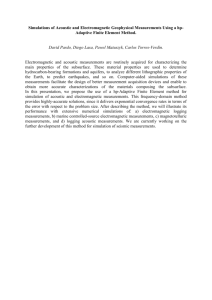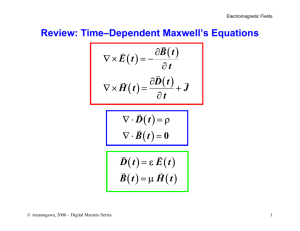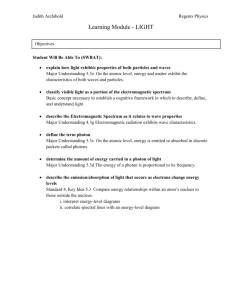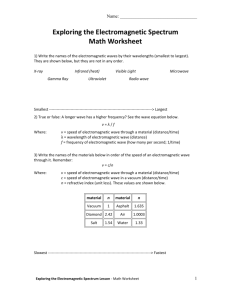Results in 2002 - TU Delft Medewerkers
advertisement
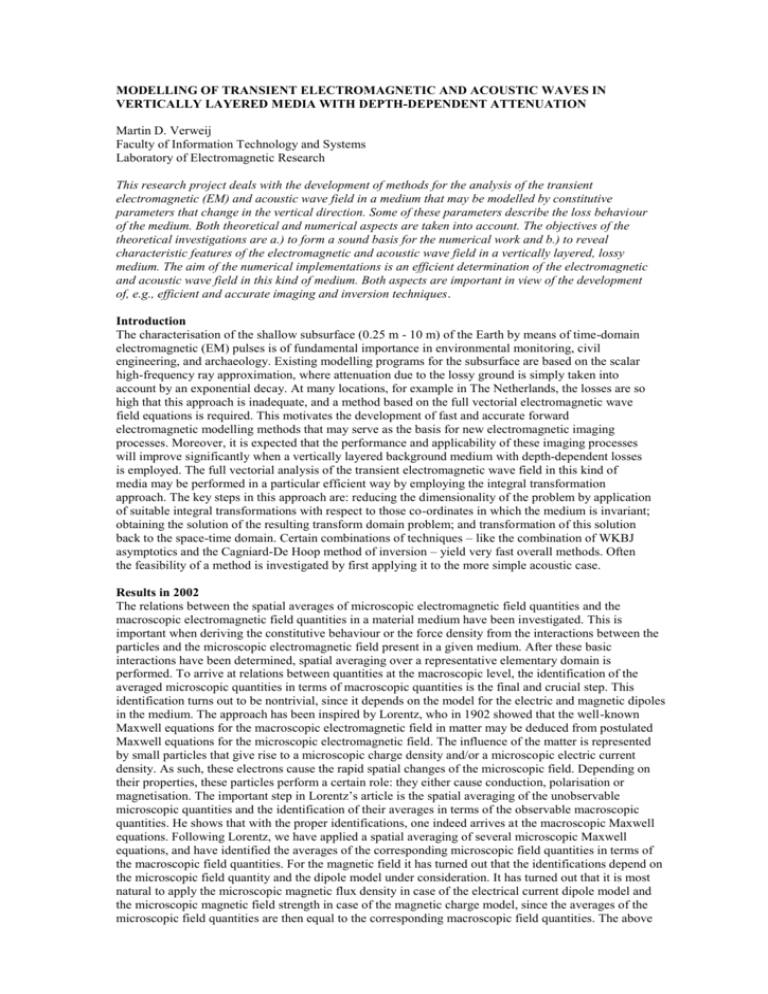
MODELLING OF TRANSIENT ELECTROMAGNETIC AND ACOUSTIC WAVES IN VERTICALLY LAYERED MEDIA WITH DEPTH-DEPENDENT ATTENUATION Martin D. Verweij Faculty of Information Technology and Systems Laboratory of Electromagnetic Research This research project deals with the development of methods for the analysis of the transient electromagnetic (EM) and acoustic wave field in a medium that may be modelled by constitutive parameters that change in the vertical direction. Some of these parameters describe the loss behaviour of the medium. Both theoretical and numerical aspects are taken into account. The objectives of the theoretical investigations are a.) to form a sound basis for the numerical work and b.) to reveal characteristic features of the electromagnetic and acoustic wave field in a vertically layered, lossy medium. The aim of the numerical implementations is an efficient determination of the electromagnetic and acoustic wave field in this kind of medium. Both aspects are important in view of the development of, e.g., efficient and accurate imaging and inversion techniques. Introduction The characterisation of the shallow subsurface (0.25 m - 10 m) of the Earth by means of time-domain electromagnetic (EM) pulses is of fundamental importance in environmental monitoring, civil engineering, and archaeology. Existing modelling programs for the subsurface are based on the scalar high-frequency ray approximation, where attenuation due to the lossy ground is simply taken into account by an exponential decay. At many locations, for example in The Netherlands, the losses are so high that this approach is inadequate, and a method based on the full vectorial electromagnetic wave field equations is required. This motivates the development of fast and accurate forward electromagnetic modelling methods that may serve as the basis for new electromagnetic imaging processes. Moreover, it is expected that the performance and applicability of these imaging processes will improve significantly when a vertically layered background medium with depth-dependent losses is employed. The full vectorial analysis of the transient electromagnetic wave field in this kind of media may be performed in a particular efficient way by employing the integral transformation approach. The key steps in this approach are: reducing the dimensionality of the problem by application of suitable integral transformations with respect to those co-ordinates in which the medium is invariant; obtaining the solution of the resulting transform domain problem; and transformation of this solution back to the space-time domain. Certain combinations of techniques – like the combination of WKBJ asymptotics and the Cagniard-De Hoop method of inversion – yield very fast overall methods. Often the feasibility of a method is investigated by first applying it to the more simple acoustic case. Results in 2002 The relations between the spatial averages of microscopic electromagnetic field quantities and the macroscopic electromagnetic field quantities in a material medium have been investigated. This is important when deriving the constitutive behaviour or the force density from the interactions between the particles and the microscopic electromagnetic field present in a given medium. After these basic interactions have been determined, spatial averaging over a representative elementary domain is performed. To arrive at relations between quantities at the macroscopic level, the identification of the averaged microscopic quantities in terms of macroscopic quantities is the final and crucial step. This identification turns out to be nontrivial, since it depends on the model for the electric and magnetic dipoles in the medium. The approach has been inspired by Lorentz, who in 1902 showed that the well-known Maxwell equations for the macroscopic electromagnetic field in matter may be deduced from postulated Maxwell equations for the microscopic electromagnetic field. The influence of the matter is represented by small particles that give rise to a microscopic charge density and/or a microscopic electric current density. As such, these electrons cause the rapid spatial changes of the microscopic field. Depending on their properties, these particles perform a certain role: they either cause conduction, polarisation or magnetisation. The important step in Lorentz’s article is the spatial averaging of the unobservable microscopic quantities and the identification of their averages in terms of the observable macroscopic quantities. He shows that with the proper identifications, one indeed arrives at the macroscopic Maxwell equations. Following Lorentz, we have applied a spatial averaging of several microscopic Maxwell equations, and have identified the averages of the corresponding microscopic field quantities in terms of the macroscopic field quantities. For the magnetic field it has turned out that the identifications depend on the microscopic field quantity and the dipole model under consideration. It has turned out that it is most natural to apply the microscopic magnetic flux density in case of the electrical current dipole model and the microscopic magnetic field strength in case of the magnetic charge model, since the averages of the microscopic field quantities are then equal to the corresponding macroscopic field quantities. The above research has been presented at the 27th General Assembly of the International Union of Radio Science, Maastricht, The Netherlands As a former co-supervisor of the thesis project ‘Detection and characterisation of defects in steel constructions,’ the collaboration with Dr. M.C.M. Bakker (Civil Engineering) on ultrasonic inspection techniques has been continued. This has resulted in a paper in which two models of ultrasonic transducers have been validated by comparison of the modelled and measured wavefield patterns, directivities, and time domain signals. The thesis project has continued as a STW project, in which participation in the ‘Users Group’ has taken place. Research plan for 2003 The theory of transforming the solution of a wave problem into the solution of anything in between a diffusion problem and a wave problem will be generalised and published. Collaboration with Dr. M.C.M. Bakker on ultrasonic inspection techniques is continued. The task of deriving the electromagnetic Green’s tensors for a multilayer medium, announced for 2002, will be part of the thesis research of a M.Sc. student. Application of these tensors will be demonstrated in a nano-optical application. The modelling of the sound field in a non-linear and dispersive acoustic medium is started as a new research topic. Publications and presentations in 2002 Bakker, M.C.M, M.D. Verweij; An approximation to the far field and directivity of elastic wave transducers, J. Acoust. Soc. Am., Vol. 111, pp. 1177-1188, 2002. Manea, T.E., M.D. Verweij, H. Blok; Electrodynamics in deformable solids for electromagnetic forming – Deformation of thin cylindrical shells, Proceedings of the Second International Conference on Advanced Computational Methods in Engineering, Liege, Belgium, 28-31 May 2002. Manea, T.E., M.D. Verweij, H. Blok; The importance of the velocity term in the electromagnetic forming process, Proceedings of the 27th General Assembly of the International Union of Radio Science, Maastricht, The Netherlands, 17-24 August 2002. Verweij, M.D.; Four ways of deducing Maxwell’s equations from their microscopic counterparts – Lorentz’s theory of electrons revisited, Proceedings of the 27 th General Assembly of the International Union of Radio Science, Maastricht, The Netherlands, 17-24 August 2002. Supervision of M.Sc. theses Lanen, E.P.A.van; An approximation to the elastodynamic far field in a plate loaded by an angle beam transducer. Huijssen, J.; Modeling of nonlinear medical ultrasound from phased array transducers. Co-supervision of Ph.D. theses Manea, T.E.; Electrodynamics in deformable solids for electromechanical power conversion and forming. Henry, F.A.G.; Fracture monitoring by borehole acoustic measurements.

